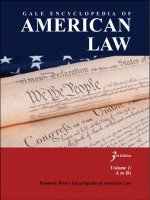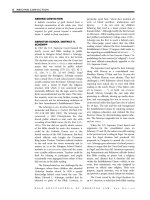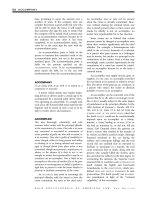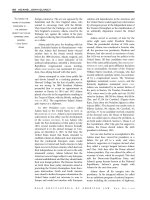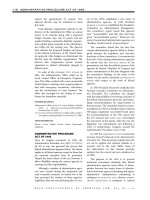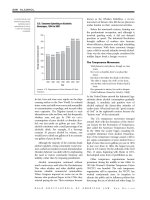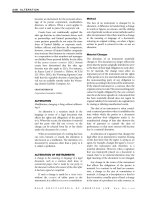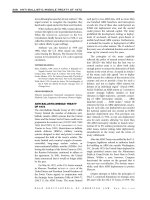Gale Encyclopedia Of American Law 3Rd Edition Volume 5 P8 pps
Bạn đang xem bản rút gọn của tài liệu. Xem và tải ngay bản đầy đủ của tài liệu tại đây (204.82 KB, 10 trang )
governments, quasi-governmental bodies, and
private organizations in their capacity as recipients
under, or administrators for, federal aid programs
that are financed by loans, advances, grants, and
contributions. The interest of the GAO also
extends to certain activities of those parties that
have negotiated contracts with the government.
The audit activities of the GAO also include
examining and settling accounts of the certifi-
cation, disbursement, and collection officers of
the federal government, including determina-
tions involving accountability for improper or
illegal expenditures of public funds. Balances
that the comptroller general certifies are binding
GAO’s Organizational Chart
Congressional
Relations
Opportunity and
Inclusiveness
Inspector General
Strategic Planning
and External Liaison
General Counsel
Deputy General
Counsel/
Ethics Counselor
Managing
Associate G.C.
Goal 1
Managing
Associate G.C.
Goal 2
Managing
Associate G.C.
Goal 3
Managing
Associate G.C.
Legal Services
Managing
Associate G.C.
Procurement
Law
Chief Operating
Officer
Chief Administrative
Officer/CFO
Strategic
Issues
Natural
Resources and
Environment
Information
Technology
Financial
Management
and Assurance
Defense
Capabilities and
Management
Teams
Acquisition and
Sourcing
Management
Applied
Research
and Methods
Legend:
CFO - Chief Financial Officer
The Executive Committee
Indicates a support or advisory relationship with the teams/units rather than a direct reporting relationship
Note: Everyone listed on this table, other than the Comptroller General, is an SES level manager. Also, with the exception of the Comptroller General of the United
States, the Chief Operating Officer, the Chief Administrative Officer, the Deputy Chief Administrative Officer, the Inspector General, and the General Counsel, all managers
are titled “Managing Director.”
Education,
Workforce, and
Income Security
Financial
Markets and
Community
Investment
Homeland
Security and
Justice
International
Affairs and
Trade
Physical
Infrastructure
Managing
Associate G.C.
Mission and
Operations
Public Affairs
Comptroller General
of the United States
Field Operations
Quality and
Continuous
Improvement
Health Care
Forensic Audits
and Special
Investigations
Unit
Human Capital
Information
Systems
and Technology
Services
Professional
Development
Program
Knowledge
Services
Controller/
Administrative
Services
Deputy Chief
Administrative
Officer
ILLUSTRATION BY GGS
CREATIVE RESOURCES.
REPRODUCED BY
PERMISSION OF GALE,
A PART OF CENGAGE
LEARNING.
GALE ENCYCLOPEDIA OF AMERICAN LAW, 3
RD E DITION
58 GENERAL ACCOUNTING OFFICE
on the EXECUTIVE BRANCH; however, any settled
account can be reviewed on motion by the
comptroller general or another interested party.
In its audit work, the GAO makes recom-
mendations for greater economy and efficiency
in government operations and for improving the
effectiveness of government programs. Within
this audit authority is a responsibility to report
significant matters to Congress for information
and use in carrying out its legislative and
executive branch surveillance functions.
Accounting
The comptroller general has the following
statutory responsibilities with respect to the
accounting systems of federal agencies:
n
Prescribe the accounting principles, stan-
dards, and related requirements to be
followed by the agencies
n
Cooperate with federal agen cies in devel-
oping their accounting systems
n
Approve agency accounting systems when
they are deemed adequate and meet pre-
scribed principles, standards, and related
requirements
n
Review, from time to time, agency account-
ing systems in operation
n
Conduct—jointly with the Office of
Management and Budget, the
TREASURY
DEPAR TM E NT
, and the Office of Personnel
Management—a continuous program to
improve accounting and financial report-
ing in the federal government
By law, the comptroller general cooperates
with the secretary of the Treasury and the
director of the Office of Management and
Budget in developing for use by all federal
agencies standardized information and data-
processing systems and also standard terminol-
ogy, definitions, classifications, and codes for
federal fiscal, budgetary, and program-related
data and information.
Legal Services and Decisions
The legal work of the GAO is centered at the
headquarters office in its Office of the General
Counsel.
The comptroller general makes final deter-
minations as to the legality of actions taken by
federal departments and agencies with regard to
accountability for the use of public funds. These
determinations are made in connection with
actions that are already taken and on an advance
basis upon request by certain responsible officers
of the government. Decisions of the comptroller
general concerning the legality of payments may
arise from the audit work of the GAO or may be
applied for by the heads of departments or
agencies or by certifying and disbursing officers
with regard to payments to be made or as a result
of congressional inquiries.
The comptroller general also considers
questions that arise in connection with the
award of government contracts and certain
contracts under government grants. Statutory
and regulatory procedures precisely define the
manner in which these government awards are
to be made, and those competing for such
awards who believe that requirements have not
been met in any particular instance may apply
to the comptroller general for a determination.
The legal work of the GAO also covers a
wide range of advisory services: to Congress, its
committees, and members, with respect to the
legal effect of statutory provisions and implica-
tions of proposed legislation as well as assistance
in drafting legislation; to the
JUSTICE DEPARTMENT,
primarily in the form of litigation reports on
court cases generated by, or related to, the work
of the GAO; and to the courts in connection
with cases involving the award of government
contracts. In addition, there is daily coordina-
tion between the staff of the Office of the
General Counsel and the audit and operating
staffs with regard to the legal consequences of
issues raised in the course of reviews of
government activities.
Claims Settlement and Debt Collection
The GAO settles claims by and against the
United States as required by law. Claims may
involve individuals; business entities; or foreign,
state, and municipal governments as claimant
or debtor. Settlement of these claims by the
GAO is binding upon executive branch agen-
cies. However, the comptroller general may
review any settled claim on his or her own
initiative or at the request of an interested party.
Claimants and debtors have further recourse to
the Congress or to the courts.
Where an administrative agency has been
unable to collect a debt due the government, the
debt is certified to the GAO as uncollectible. After
determining the amount due the United States,
the GAO superintends its recovery, and ultima-
tely makes final settlement and adjustment.
GALE ENCYCLOPEDIA OF AMERICAN LAW, 3RD E DITION
GENERAL ACCOUNTING OFFICE 59
Energy Data Verification
Under the Energy Policy and Conservation Act
(42 U.S.C.A. 6201), approved December 22,
1975, the comptroller general is empowered to
conduct verification examinations of energy-
related information developed by private busi-
ness concerns under certain circumstances
delineated in the act. For the purpose of
carrying out this authority, the comptroller
general may issue subpoenas, require written
answers to
INTERROGATORIES, administer oaths,
inspect business premises, and inspect and copy
specified books and records. Certain enforce-
ment powers are provided, including, for some
types of noncompli ance, the power to assess
civil penalties and to collect such penalties
through
CIVIL ACTION.
Rules, Regulations, and Decisions
The comptroller general makes such rules and
regulations as deemed necessary for carrying on
the work of the GAO, including those for the
admission of attor neys to practice before it.
Under the
SEAL of the office, he or she furnishes
copies of records from books and proceedings
thereof, for use as
EVIDENCE in accordance
with the act of June 25, 1948 (62 Stat. 946; 28
U.S.C.A. 1733).
The GAO Personnel Act of 1980 (94 Stat.
27; 31 U.S.C.A. 52–1), approved February 15,
1980, requires the comptroller general to
establish an independent personnel manage-
ment system for employees of the GAO. The
system would not be subject to regulation or
oversight of executive branch agencies. Employ-
ee rights, such as appeals from adverse actions,
are protected by creation of a GAO Personnel
Appeals Board.
The GAO “Policy and Procedures Manual
for Guidance of Federal Agencies” is the official
medium through which the comptroller general
promulgates principles, standards, and related
requirements for accounting to be observed by
the federal departments and agencies; uniform
procedures for use by the federal agencies; and
regulations governing the relationships of the
GAO with other federal agencies and with
individuals and private concerns
DOING BUSINESS
with the federal government.
All decisions of the comptro ller general of
general import are published in monthly
pamphlets and in annual volumes.
GAO Reports
As required by law, a list of GAO reports issued
or released during the previous month is
furnished monthly to Congress, its committees,
and its members.
Copies of GAO reports are provided
without charge to members of Congress and
congressional committee staff members; offi-
cials of federal, state, local, and foreign govern-
ments; members of the press; college libraries,
faculty members, and students; and nonprofit
organizations.
Since the late 1990s the GAO has worked to
place more information on its web site. It has
placed a large archive of its reports online and
publishes current reports. These include legal
decisions, opinions, and a vast array of
resources to help both federal agencies and the
general public. In addition, it has placed its bid-
protest
DOCKET online and has established
FraudNet, which allows persons to file allega-
tions of government
FRAUD online and it has
established an email hotline for reporting small
business fraud and abuse.
FURTHER READINGS
General Accounting Office Website. Available online at
www.gao.gov (accessed May 25, 2009).
CROSS R EFERENCES
Congress of the United States; Federal Budget; Office of
Management and Budget; Treasury Department.
GENERAL AGREEMENT ON TARIFFS
AND TRADE
The GENERAL AGREEMENT ON TARIFFS AND TRADE
(GATT) originated with a meeti ng of 22 nations
meeting in 1947 in Geneva, Switzerland. By
2000 there were 142 member nations, with
another 30 countries seeking admission. The
detailed commitments by each country to limit
tariffs on particular items by the amount
negotiated and specified in its tariff schedule is
the central core of the GATT system of
international obligation.
The obligations relatin g to the tariff sche-
dules are contained in Article II of GATT. For
each
COMMODITY listed on the schedule of a
country, that country agrees to charge a tariff
that will not exceed an amount specified in the
schedule. It can, if it wishes, charge a lower
tariff.
GALE ENCYCLOPEDIA OF AMERICAN LAW, 3RD E DITION
60 GENERAL AGREEMENT ON TARIFFS AND TRADE
The World Trade Organization (WTO)
heavily influences the workings of the GATT
treaties through the efforts of various commit-
tees. Representatives of member countries of
the WTO comprise the Council for the Trade in
Goods (Goods Council), which oversees the
work of 11 committees responsible for oversee-
ing the various sectors of GATT. The commit-
tees focus on such issues as agriculture, sanitary
measures, subsidies, customs valuation, and
rules of origin.
FURTHER READINGS
Bagwell, Kyle, and Robert W. Staiger. 2002. The Economics of
the World Trading System. Cambridge, MA: MIT Press.
Irwin, Douglas A., Petros C. Mavroidis, and Alan O. Sykes.
2009. The Genesis of the GATT. New York: Cambridge
Univ. Press.
World Trade Organization Web site. 2009. Available online
at (accessed September 3, 2009).
CROSS REFERENCES
Commodity; Tariff.
GENERAL APPEARANCE
The act by which a defendant completely consents
to the jurisdiction of the court by appearing before
it either in person or through an authorized
representative thereby waiving any jurisdictional
defects that might be raised except for that of the
competency of the court.
A
GENERAL APPEARANCE differs from a SPECIAL
APPEARANCE
in which a DEFENDANT agrees to
submit to the
JURISDICTION of the court for a
restricted purpose, such as to test whether the
SERVICE OF PROCESS made upon him or her was
legally sufficient.
GENERAL AVERAGE LOSS
General average loss refers to the distribution of
maritime loss among various interests of vessels
and cargo.
The general average rules apply to losses that
are incurred for the common benefit of
participants in a maritime venture. These rules
establish that losses should be shared ratably by
those who participate in a venture. The doctrine
of
GENERAL AVERAGE LOSS is based on the principle
that a voluntary sacrifice of a portion of the ship
or cargo to save the remaining property and lives
should be made good by all interests exposed to
the common peril and saved by the sacrifice.
General average loss is the opposite of
PARTICULAR AVERAGE LOSS, which applies when a
sacrifice was made for a separate interest or for
a reason other than the common benefit of
vessel and cargo.
CROSS REFERENCES
Admiralty and Maritime Law.
GENERAL CREDITOR
An individual to whom money is due from a
debtor, but whose debt is not secured by property
of the debtor. One to whom property has not been
pledged to satisfy a debt in the event of nonpay-
ment by the individual owing the money.
GENERAL EXECUTION
A court order commanding a public official, such
as a sheriff, to take the personal property of a
defendant to satisfy the amount of a judgment
awarded against such defendant.
When such officer is given the authority to
seize only particular property or types of
property, the writ or order is sometimes known
as a special execution.
GENERAL INTENT
In criminal law and tort law, a mental plan to do
that which is forbidden by the law.
Unlike offenses that require a
SPECIFIC
INTENT
, it is not necessary that the ACCUSED
intend the precise harm or result. It is sufficient
if the person meant to do the act that caused the
harm or result. For example,
BATTERY is a
GENERAL INTENT offense. If a DEFENDANT commits
a battery that results in harm to the victim, it
does not matter if the defendant did not intend
the harm.
GENERAL JURISDICTION
The legal authority of a court to entertain
whatever type of case comes up within the
geographical area over which its power extends.
GENERAL JURISDICTION differs from special or
limited
JURISDICTION, which is the power of a
COURT to hear only certain types of cases, or those
in which the
AMOUNT IN CONTROVERSY is below a
certain sum or that is subject to exceptions.
GENERAL LEGACY
A monetary gift, payable out of the collective assets
of the estate of a testator—one who makes a
will—and not from a designated source.
GALE ENCYCLOPEDIA OF AMERICAN LAW, 3RD E DITION
GENERAL LEGACY 61
Unlike a SPECIFIC LEGACY,aGENERAL LEGACY is not
subject to ADEMPTION, extinction that results when
a testator revokes his or her intention to leave
designated property to another either by altering
the property or removing it from the estate.
GENERAL SERVICES
ADMINISTRATION
The GENERAL SERVICES ADMINISTRATION (GSA) was
established by section 101 of the
FEDERAL
Property and Administrative Services Act of
1949 (40 U.S.C.A. § 751). The GSA sets policy
for and manages government property and
records. More specifically, GSA duties include
the construction and operation of buildings;
procurement and distribution of supplies ;
utilization and disposal of property; manage-
ment of transportation, traffic, and commu-
nications; and management of the government’s
automatic data processing resources program.
Like a large business
CONGLOMERATE, the GSA
conducts business in many different areas and
operates on different levels of organization: the
central Washington, D.C ., office, 11 regional
offices, and field activities.
The GSA is a large organization, the structure
of which consists of several tiers of adminis-
trators, offices, bureaus, and support agencies.
U.S. General Services Administration
White House
Liaison
Under the Office of
the Administrator
New England
Region 1
Boston, MA
Northeast and
Caribbean
Region 2
New York, NY
Mid-Atlantic
Region 3
Philadelphia, PA
Southeast Sunbelt
Region 4
Atlanta, GA
The Heartland
Region 6
Kansas City, MO
Greater
Southwest
Region 7
FT. Worth, TX
Rocky Mountain
Region 8
Denver, CO
Pacific Rim
Region 9
San Francisco, CA
Great Lakes
Region 5
Chicago, IL
Northwest/Arctic
Region 10
Auburn, WA
National Capital
Region 11
Washington, DC
Deputy Administrator
National Services Regional Services Central Office
Administrator
Office of the Administrator
Chief of Staff
Federal
Acquisition
Service
Public
Buildings
Service
Office of
Inspector
General
Civilian Board
of Contract
Appeals
Office of the Chief
Acquisition Officer
Office of the Chief
Financial Officer
Office of the Chief
Information Officer
Office of the Chief
Human Capital
Officer
Office of Congressional
and Intergovernmental
Affairs
Office of Emergency
Response & Recovery
Office of
General Counsel
Office of
Governmentwide
Policy
Office of Citizen
Services and
Communications
Office of
Performance
Improvement
Office of
Civil Rights
Office of Small
Business Utilization
ILLUSTRATION BY GGS
CREATIVE RESOURCES.
REPRODUCED BY
PERMISSION OF GALE,
A PART OF CENGAGE LE-
ARNING.
GALE ENCYCLOPEDIA OF AMERICAN LAW, 3
RD E DITION
62 GENERAL SERVICES ADMINISTRATION
The first level in the HIERARCHY of the GSA
consists of the administrator, the deputy admin-
istrator, and the chief of staff. The administrator
is the principal director for the entire organiza-
tion, assisted by a deputy and chief of staff.
The second tier in the GSA organization
consists of four main offices: the Federal Supply
Service, Federal Technology Service, Public
Buildings Service, and the Office of Govern-
mentwide Policy. These four offices oversee the
majority of the agency’s work and collectively
form the public face of the GSA.
The Federal Supply Service (FSS) provides
low-price, quality goods and services to federal
departments and agencies. Its services include
governmentwide programs for the management
of transportation, mail, and travel; audits of
transportation; management of a federal fleet;
and management of aircraft owned or operated
by civilian agencies in support of government
missions.
The FSS provides more than $25 billion
annually in common-use goods and services to
federal agencies. It emphasizes purchasing en-
vironmentally safe products, and services and
supplies more than 3,000 environmentally ori-
ented products to the federal government, such
as retread tires, shipping boxes made with
recycled materials, and water-saving devices.
The service also coordinates a worldwide
program for the management of government
property, through the Office of Property Dis-
posal, which is responsible for allocating excess
personal property among the agencies and donat-
ing or disposing of property through public sales.
The FSS Interagency Fleet Management
Program controls approximately 185,000 vehi-
cles, purchasing more than 58,000 new vehicles
annually. The FSS also acts as the government’s
civilian freight manager by providing rating and
routing services to customer agencies and
overnight delivery of small packages at reduced
rates, and managing the postpayment
AUDIT of
freight and passenger transportation bills.
Information Technology Service The Federal
Technology Service (FTS) directs government-
wide programs for automated data processing
and local
TELECOMMUNICATIONS equipment and
services, coordinates programs for federal
records and infor mation management practices,
and provides in formation to the public through
the Federal Information Center.
The FTS helps federal agencies manage
information resources through the Office of
Information Technology
INTEGRATION (ITI). The
ITI provides assistance through three program s:
the Federal Systems Integration and Manage-
ment System, Federal Computer Ac quisition
Center, and Federal Information System Sup-
port Program. The ITS also procures automatic
data processing and telecommunications hard-
ware, software, and services involving informa-
tion resources of governmentwide agencies.
In addition to technical assistance, the
service provides various management assistance
programs and policies to governmentwide
agencies concerning information-related func-
tions and activities. It is in charge of the GSA’s
governmentwide telecommunications service
and assists with the interagency Informatio n
Resources Management infrastructure. It also
provides internal information systems manage-
ment for the GSA.
The FTS’s Office of Information Security
supports all government activities conducting
sensitive and classified national security, diplo-
matic, and
DEFENSE DEPARTMENT missions.
Another program overseen by FTS is the
Federal Information Center Program, which is
a clearinghouse for information about the
federal government. The center answers ques-
tions regarding government programs and refers
people to the appropriate agency. Depending
upon their geographic location, residents may be
able to access the center through a toll-free
telephone number. Another resource, the Federal
Domestic Assistance Catalog Program, provides
information on federally operated programs that
offer domestic assistance, such as loans, grants,
and
INSURANCE, to interested persons.
The FTS also offers the Federal Information
Relay Service to help hearing-impaired and
speech-impaired individuals communicate with
the government. The service manages numerous
programs that maintain information on equip-
ment, goods, and services bought by the govern-
ment. The information is available to the public.
The Public Buildings Service (PBS) designs,
builds, leases, repairs, and maintains approxi-
mately 7,300 federally controlled buildings in
the United States. The service is also responsible
for property management information systems
throughout the government and for the main-
tenance of public utilities and their costs.
GALE ENCYCLOPEDIA OF AMERICAN LAW, 3RD E DITION
GENERAL SERVICES ADMINISTRATION 63
The Office of Governmentwide Policy (OGP)
functions to ensure that governmentwide policies
allow and encourage agencies to develop and
utilize the best, most cost effective management
practices for the conduct of their specific
programs. The OGP consolidates GSA govern-
mentwide policy-making activities within one
central office. These activities include the
government’s plans for acquiring some $200
billion per year in goods and services, the $8
billion a year the government spends on
government travel, and the tens of billions of
dollars spent each year on internal administrative
management systems. The OGP is focused on re-
engineering the traditional policy development
model to emphasize collaborative development.
The third tier in the organizational structure
of the GSA contains 11 regional offices: New
England Region, Northeast and Caribbean Re-
gion, Mid-Atlantic Region, Southeast Sunbelt
Region, Great Lakes Region, The Heartland
Region, Greater Southwest Region, Rocky Moun-
tain Region, Pacific Rim Region, Northwest/
Arctic Region, and the National Capitol Region.
These offices are distributed to facilitate the work
of the GSA in diverse areas of the country.
The fourth level in the structural hierarchy
of the GSA consists of ten offices that support
all GSA services: the Offices of the Chief
Financial Officer, Office of the Chief People
Officer, Office of Congressional & Interg overn-
mental Affairs, Office of Services and Commu-
nications, Office of the Chief Information
Officer, Office of Small Business Utilization,
Office of Performance Improvement, Office of
General Counsel, Office of
CIVIL RIGHTS, Office
of Inspector General, along with the GSA Board
of Contract Appeals.
The Office of Portfolio Management man-
ages all aspects of the portfolio management
business line at the national level.
FURTHER READINGS
General Services Administration. 2003. U.S. General Services
Administration Guide to Federal Government Sales.
Washington, D.C.:.U.S. Independent Agencies and
Commissions.
U.S. General Services Administration. Available online at
(accessed July 25, 2009).
U.S. Government Manual Website. Available online at http://
www.gpoaccess.gov/gmanual/index (accessed July 21,
2009).
CROSS REFERENCES
Personal Property; Telecommunications.
GENERAL TERM
A sitting of the court en banc, with the
participation of the entire membership of the
court rather than the regular quorum. A phrase
used in some jurisdictions to signify the ordinary
session of a court during which the trial determin-
ation of actions occur.
GENERAL TERM is distinguishable from SPECIAL
TERM
, in that the latter entails the HEARING of
motions, which are applications for court
orders, arguments, the
DISPOSITION of various
types of formal business, or the trial of a special
list or class of cases.
GENERAL VERDICT
A decision by a jury that determines which side in
a particular controversy wins, and in some cases,
the amount of money in damages to be awarded.
GENERAL WARRANTY DEED
Another name for a WARRANTY DEED.
GENERAL WELFARE
The concern of the government for the health,
peace, morality, and safety of its citizens.
Providing for the
WELFARE of the general
public is a basic goal of government. The
PREAMBLE to the U.S. Constitution cites promo-
tion of the
GENERAL WELFARE as a primary reason
for the creation of the Constitution. Promotion
of the general welfare is also a stated purpose in
state constitutions and statutes. The concept has
sparked controversy only as a result of its
inclusion in the body of the U.S. Constitution.
The first clause of Article I, Section 8, reads,
“The Congress shall have Power To lay and
collect Taxes, Duties,
IMPOSTS and Excises, to pay
the Debts and provide for the common Defence
and general Welfare of the United States.” This
clause, called the General Welfare Clause or the
SPENDING POWER Clause, does not grant Congress
the power to legislate for the general welfare
of the country; that is a power reserved to the
states through the
TENTH AMENDMENT. Rather, it
merely allows Congress to spend
FEDERAL money
for the general welfare. The principle underlying
this distinction—the limitation of federal
power—eventually inspired the only important
disagreement over the meaning of the clause.
According to
JAMES MADISON, the clause
authorized Congress to spend money, but only
GALE ENCYCLOPEDIA OF AMERICAN LAW, 3RD E DITION
64 GENERAL TERM
to carry out the powers and duties specifically
ENUMERATED in the subsequent clauses of Article I,
Section 8, and elsewhere in the Constitution, not
to meet the seemingly infinite needs of the
general welfare.
ALEXANDER HAMILTON maintained
that the clause granted Congress the power to
spend without limitation for the general welfare
of the nation. The winner of this debate was not
declared for 150 years.
In United States v. Butler, 56 S. Ct. 312, 297
U.S. 1, 80 L. Ed. 477 (1936), the U.S. Supreme
Court invalidated a federal agricultural spend-
ing program because a specific congressional
power over agr icultural production appeared
nowhere in the Constitution. According to the
Court in Butler, the spending program invaded
a right reserved to the states by the Tenth
Amendment.
Though the Court decided that Butler was
consistent with Madison’s philosophy of limited
federal government, it adopted Hamilton’s
INTERPRETATION of the General Welfare Clause,
which gave Congress broad powers to spend
federal money. It also established that determi-
nation of the general welfare would be left to the
discretion of Congress. In its opinion, the Court
warned that to challenge a federal expense on
the ground that it did not promote the general
welfare would “naturally require a showing that
by no reasonable possibility can the challenged
legislation fall within the wide range of discre-
tion permitted to the Congress.” The Court
then obliquely confided, “[H]ow great is the
extent of that range we need hardly
remark.”“[D]espite the breadth of the legislative
discretion,” the Court continued, “our duty to
hear and to render judgment remains.” The
Court then rendered the federal agricultural
spending program at issue invalid under the
Tenth Amendment.
With Butler as precedent, the Supreme
Court’s interest in determining whether congres-
sional spending promotes the general welfare has
withered. In South Dakota v. Dole, 483 U.S. 203,
107 S. Ct. 2793, 97 L. Ed. 2d 171 (1987), the
Court reviewed legislation allowing the secretary
of transportation to withhold a percentage of
federal highway funds from states that did not
raise their legal drinking age to twenty-one. In
holding that the statute was a valid use of
congressional spending power, the Court in Dole
questioned “whether ‘general welfare’ is a
judicially enforceable restriction at all.”
Congress appropriates money for a seem-
ingly endless number of national interests,
ranging from federal courts, policing,
IMPRISON-
MENT
, and national security to social programs,
environmental protection, and education. N o
federal court has struck down a spending
program on the ground that it failed to promote
the general welfare. However, federal spending
programs have been struck down on other
CONSTITUTIONAL grounds.
FURTHER READINGS
Rosenthal, Albert J. 1987. “Conditional Federal Spending
and the Constitution.” Stanford Law Review 39.
Sky, Theodore. 2004. To Provide for the General Welfare: A
History of the Federal Spending Power. Newark, DE:
Univ. of Delaware Press.
Sorenson, Leonard. 1995. Madison on the “General Welfare ”
of America. New York: Rowman & Littlefield.
CROSS REFERENCES
Congress of the United States; Constitution of the United
States; Federal Budget; Federalism.
GENERALLY ACCEPTED
ACCOUNTING PRINCIPLES
The standard accounting rules, regulations, and
procedures used by companies in maintaining
their financial records.
GENERALLY ACCEPTED ACCOUNTING PRINCIPLES
(GAAP) provide companies and accountants
with a consistent set of guidelines that cover
both broad
ACCOUNTING principles and specific
practices. For example, accountants use GAAP
standards to prepare financial statements.
In response to the
STOCK MARKET crash of
1929 and the ensuing Great Depression, Con-
gress passed the
SECURITIES Act in 1933 and the
Securities Exchange Act in 1934. Among other
things, these acts established a methodology for
standardizing accounting practices among pub-
licly held companies. The task of creating and
maintaining accounting standards was handled
by the American
INSTITUTE of Certified Public
Accountants (AICPA) from 1936 until 1973. In
1973, the responsibility was taken over by the
Financial Accounting Standards Board (FASB),
which was established the same year.
The Financial Accounting Standards Advi-
sory Council (FASAC ), which is composed of
33 members from both the public and private
sectors, advises the FASB on matters that may
affect or influence GAAP rules. These 33
individuals meet quarterly to discuss accounting
GALE ENCYCLOPEDIA OF AMERICAN LAW, 3RD E DITION
GENERALLY ACCEPTED ACCOUNTING PRINCIPLES 65
issues and gather information, which they then
present to FASB. Essentially, FASAC serves as
FASB’s sounding board. FASAC is overseen by
the Financial Accounting Foundation, an inde-
pendent organization whose 16-member board
of trustees chooses FASAC’s 33 members. The
FASB is also monitored by the Corporation
Finance division of the
SECURITIES AND EXCHANGE
COMMISSION
(SEC). Among the organizations that
influence GAAP rules are the AICPA and the
INTERNAL REVENUE SERVICE (IRS).
Other countries have their own GAAP rules,
which are set by their versions of the FASB. For
example, the Canadian Institute of Chartered
Accountants (CICA) sets GAAP standards in
Canada.
Publicly held companies are required to
conform to GAAP standards. Specifically, the
Securities Act and the Securities Exchange Act
established a requirement that publicly held
companies must undergo an external
AUDIT by
an independent
ACCOUNTANT once per year. In the
early 2000s, companies faced increased scrutiny
in light of the widely publicized cases involving
such major corporations as Enron and World-
Com, along with the firm of Arthur Andersen,
one of the world’s largest accountancy firms. In
the case of Enron, for example, the company
manipulated its financial information to give the
appearance that revenues were much higher than
they actually were. After the company declared
BANKRUPTCY in 2001, Arthur Andersen came under
attack because its auditors had signed off on
Enron’s financials despite numerous misgivings.
Andersen was found
GUILTY of obstruction of
justice by a jury in Houston, Texas, in June 2002.
In July 2002, President
GEORGE W. BUSH
signed the Sarbanes-Oxley Act, which estab-
lished new regulations for accounting reform
and investor protection. Among the provisions
of Sarbanes-Oxley was the creation of the five-
member Public Company Accounting Over-
sight Board, overseen by the SEC. Accounting
firms that audit publicly held companies are
required to register with the board, which has
the authority to inspect audits. Sarbanes-Oxley
also requires chief executive officers and chief
financial officers of publicly held companies to
provide a statement attesting to the veracity of
their financial statements.
FURTHER READINGS
Financial Accounting Standards Board Web site. Available
online at (accessed July 26, 2009).
Schilit, Howard, 2010. Financial Shenanigans: How to Detect
Accounting Gimmicks and Fraud on Financial Reports.
New York: McGraw-Hill.
Squires, Susan E., et al. 2003. Inside Arthur Andersen: Shifting
Values, Unexpected Consequences. Upper Saddle River,
NJ: Prentice-Hall.
United States Securities and Exchange Commission Web
site. Available online at (accessed
July 26, 2009).
GENETIC ENGINEERING
The human manipulation of the genetic material
of a cell.
GENETIC ENGINEERING involves the process of
isolating individual DNA fragments, coupling
them with other genetic material, and causing
the genes to replicate themselves. Introducing
this newly created complex to a host cell causes
it to multiply and produce clones that can later
be harvested and used for a variety of purposes.
Current applications of the technology include,
but are not limited to, medical investigations of
gene structure for the control of genetic disease
(particularly through antenatal diagnosis); food
crop development to resist plant disease or
harsh weather; the creation of new antibiotic
and antiviral drugs; genetic cloning to save
endangered species; and the development of
sustainable energy through bio-fuels. The syn-
thesis of hormones and other proteins (e.g.,
growth hormone and insulin), which are
otherwise obtainable only in their natural state,
is also of interest to scientists.
International Codes and Ethical
Issues for Society
An international code of ethics for genetic research
was first established in the World Medical
Association’s Declaration of Helsinki in 1964.
The guide prohibited outright most forms of
genetic engineering and was accepted by numer-
ous U.S. professional medical societies, including
the
AMERICAN MEDICAL ASSOCIATION (AMA).
In 1969 the AMA promulgated its own ethical
guidelines for clinical investigation, key provisions
of which conflicted with the Helsinki Declaration.
For example, the AMA guidelines proposed that
when mentally competent adults were found to be
unsuitable subjects for genetic engineering stu-
dies, minors or mentally incompetent subjects
could be used instead. The Helsinki Declaration
did not condone testing on humans.
The growth of genetic engineering in
the 1970s aroused international concern, but
GALE ENCYCLOPEDIA OF AMERICAN LAW, 3RD E DITION
66 GENETIC ENGINEERING
governments and medical societies took only
limited measures to control it. Concern focused
on the production of dangerous bacterial
mutants that could be used as harmful eugenics
tools or
WEAPONS. The Genetic Manipulation
Advisory Group was established in England
based on the recommendations of a prominent
medical group, the Williams Committee. Scien-
tists were required to consult this group before
carrying out any activity involving genetic
manipulation in England. Additional measures
required scientific laboratories throughout
the world to include physical containment labs
to prevent manipulated genes from escaping
and surviving in natural conditions. These
policies were subsequently adopted in the
United States.
In 2000 a group of 138 countries, including
the United States, approved the Cartagen a
Protocol on Biosafety Environment. Interna-
tional concerns over the handling of genetically
modified organisms (GMOs) prompted the
passage of the protocol. It governs such issues
as the safe transfer, handling, use, and disposals
of GMOs among member countries.
Another area of developing law, summarized
by Sonia Miller in a May 29, 2007, article in The
New York Law Journal, concerns genetic privacy.
With the advancement of genetic engineering
technology comes the human benefit of having
disease, deformity, and
DISABILITY potentially
eradicated, enhancing life and health expectan-
cies, and a better world as a whole. However, the
same innovation has the potential to be misused
for purposes of creating, and perceiving as
superior, “designer babies,” and genetics-based
economic or social communities. Critics of the
developing field warn that
INSURANCE companies
and employers may misuse private genetic
information about individuals to discriminate.
Both houses in Congress have contemplated
LEGISLATION that would prohibit DISCRIMINATION on
the basis of genetic information, and would
extend privacy and confidentiality requirements.
(See, e.g., prior legislative efforts such as the
Genetic Information Nondiscrimination Act of
2007 (H.R. 493, S. 358).)
The Breakdown of Regulation:
Genetic Inventions and Patents
in the United States
In 1980 the U.S. Supreme Court created an
economic incentive for companies to develop
genetically engineered products by holding that
such products could be patented. In Diamond v.
Chakrabarty, 447 U.S. 303, 100 S. Ct. 2204, 65 L.
Ed. 2d 144, the
COURT held that a PATENT could
be issued for a novel strain of bacteria that could
be used in the cleanup of oil spills. In 1986 the
U.S.
DEPARTMENT OF AGRICULTURE approved the
sale of the first living genetically altered organism.
The virus was used as a pseudorabies vaccine,
from which a single gene had been cut. Within
the next year, the U.S. Patent and Trademark
Office announced that non-naturally occurring,
non-human, multicellular living organisms, in-
cluding animals, were patentable under the
Patent Act of 1952 (35 U.S.C.A. § 101).
The Department of Agriculture formally
became involved in genetic engineering in April
1988, when the Patent and Trademark Office
issued the first animal patent, granted on a
genetically engineered mouse used in cancer
research. U.S. scientists began experiments with
the genetic engineering of farm animals, such as
creating cows that would give more milk,
chickens that would lay more eggs, and pigs that
would produce leaner meat. These developments
only raised more objections from critics who
believed that genetic experimentation on animals
violated religious, moral, and ethical principles.
In spite of the controversy, the U.S. House of
Representatives approved the Transgenic Animal
In 1997, a team
of scientists at the
Roslin Institute in
Edinburgh, Scotland,
cloned the first adult
mammal, a sheep
named Dolly.
AP IMAGES
GALE ENCYCLOPEDIA OF AMERICAN LAW, 3
RD E DITION
GENETIC ENGINEERING 67
